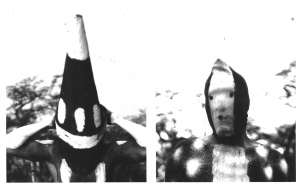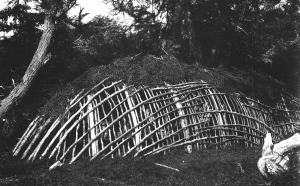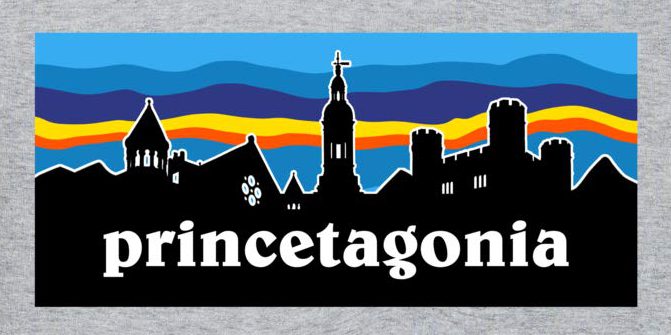Reimagining the Fuegian Landscape Through the Eyes of the Yahgan and the Selk’nam
Tierra del Fuego, the Land of Fire
The archipelago at the end of the world, Tierra del Fuego (Land of Fire) was named, in the early 16th century, by Ferdinand Magellan, the first European to explore it (1). It was named so because of the many bonfires, lit by the natives, that were sighted along the coastline by the Europeans upon arrival (2). Divided between Argentina and Chile, Tierra del Fuego is separated from continental Patagonia by the now eponymous Strait of Magellan. The landscape and ecology of Tierra del Fuego have been commoditized in order to serve the extractivist interests of national governments and industry. It is for this reason that the Fuegians, the native inhabitants of Tierra del Fuego, were violently exterminated. Tierra del Fuego’s economy is now dominated by petroleum extraction, fishing, sheep ranching and ecotourism (3).
The European gaze
“All that is inhuman here is sublime in its natural desolation. All that is human is sordid: civilization’s wastes.” (Baudrillard, 128)
“One of the harshest environments on the planet, the whole region is at the mercy of biting winds and sudden blasts of rain and snow. Dense forests of nothofagus beech hug steep mountains that plummet down to a jagged coastline where the icy waters of two great oceans crash and broil in a maelstrom that has sunk countless ships” (Moss, 11).
The dominant views and contemporary ways of thinking about and understanding Tierra del Fuego’s landscapes and environments are very different today than those that were held and practised by the Fuegians. Today “Patagonia,” more generally, brings to mind vast, forbidding, desolate, windswept landscapes. Stunningly beautiful to some, but lonely and, eventually, depressing to nearly all who venture into it. For example, in the Voyage of the Beagle, Darwin’s journal records of his travels, space is dedicated to his impressions of Tierra del Fuego. As summarised by Nouzeilles, he describes it as a “broken landscape, an unstable amalgamation of loose fragments” (256). Thus, Darwin emphasises an apparent elementality and lack of complexity or cohesiveness of the landscape. “Patagonia is not only a barren desert incapable of sustaining life, but itself a world ruled by death” (Nouzeilles 257), “a worthless vastness cursed by sterility and destined to remain identical to itself in perpetuity” (Nouzeilles 258, 259). The associations that Darwin and other western explorers, colonists and opportunists established has had deep-reaching consequences. Nouzeilles argues that this misguided understanding of the landscape as monotonous, barren and uninspiring has led us to view it as a “blank screen” upon which we might project our self-serving ambitions (258) and whose wealth we might freely appropriate by designating it “a land that holds unlimited resources that the new nation must [exploit] for the sake of progress” (253). Thus, in the contemporary imagination, Tierra del Fuego’s environments are empty spaces, void of human activity, culture, and life. However, the natives didn’t understand the landscape in this same sense. This article will draw from indigenous cosmologies and cultural histories to offer a way to reimagine Tierra del Fuego as a “place” through the lens of its indigenous peoples, rather than the romantic but barren and forbidding “space” we currently understand it to be.
Crossing the man-nature divide through anthropomorphism
Martin Gusinde, a Catholic missionary from Germany, befriended the vestiges of the Yahgan and Selk’nam peoples when he arrived in Tierra del Fuego in the early 20th century. He documented their cultural practices and spiritual beliefs, and Moss indicates that a number of Gusinde’s recorded indigenous folk tales referred to “animals and birds that shared the seas and shores with the Selk’nam – whales, albatrosses, sea lions, cormorants – and a large number of tales feature guanacos, often emphasizing the prowess needed to hunt them” (Moss, 14). People were very much a part of nature and of the wider ecosystem – unlike the western notion of a divide between humans and nature. This point is further driven in Moss’ discussion of Selk’nam creation stories and myths, where humans were made from the earth and natural events were anthropomorphised:
“Swamps, matted roots, grass tufts and dark earth feature in the creation stories, reflecting the topographies of the Selk’nam domain, and human genitalia are formed from the very mud, thus explaining the Selk’nam’s swarthy skin colour. The snowstorms sent up from Antarctica were known as xoše, personified by a marching army of strong men sent by the south wind” (Moss, 14).
Rebirth and reciprocity
Central to the Selk’nam myths, Moss writes, was “a belief that humans must learn to share land with the native fauna; for the Selk’nam, everything and everyone comes from and eventually returns to the land, even if the outward form changes” (Moss, 14). This reflects concepts of rebirth, circularity and reciprocity. Furthermore, he describes their conviction that “on death, their ancestors’ spirits passed into the surrounding landscape of mountains, lakes and rivers, or into the bodies of wild creatures” (Moss, 14). Thus, what Darwin had characterized as the “land of death” was in many ways the opposite, its various components serving as the sites of rebirth/reincarnation and giving new life to the souls of the deceased.
The Great Ceremonies of the Selk’nam and the Yahgan
The Selk’nam and the Yahgan both performed ceremonies with the purpose of initiating young boys into adulthood. While the Selk’nam had only one ceremony, called the Hain, while the Yahgan performed two – the Chiexaus and the Kina (McEwan, 84). In the Hain, the young men were known as kloketens (McEwan, 90). Post-initiation they would be adult men, or maars (McEwan, 93). In the Chiexaus, the initiates were known as ushwaala (McEwan, 94). The ceremonies were performed in sacred huts, and while the Hain hut “encapsulated the whole of Selk’nam society as a reflection of the cosmos,” the Chiexaus hut was modelled around the natural cave habitats of sea lions, their main prey (McEwan, 86).

The Hain ceremonial hut and the four skies
There were seven principal posts in the Hain ceremonial hut: four along the cardinal points representing sho’on, ‘skies’, and three between the four cardinal posts at the north-east, south-east and south-west (it is unclear why there was no post at the north-west) (McEwan, 86). The Selk’nam partitioned their land among approximately eight lineages, and these were grouped in “very large territorial units,” (McEwan, 84) each of which “belonged to one of the four skies (or to a peripheral sky), according to the territory where they were born” (McEwan, 87).
“The four skies were thought of as ‘invisible cordilleras of infinity’. The east sky, whose post was named Páhuil (a Haush word) was the most magnificent yet the most treacherous of all. Its great slippery cordillera was surrounded by a sea of boiling water. The magnificent cordillera of the west sky was the centre, or womb, of the wind (Shenu) for whom the west post of the Hain was named. The sun (Krren) was associated with the west sky, and Shenu was his brother. Shenu had assisted his brother Krren, then a powerful shaman, when they attached the Hain of the matriarchy and its dominant leader, the female shaman Moon (Kreeh). In the beautiful cordillera of the south sky lived Owl (Sheit), for whom the south post was named. His mighty brother Snow (Hosh) also lived there with their sister Moon, once sovereign of the famed matriarchy, who had been defeated by her husband Sun. Finally, the cordillera of the north sky was the home of Sea (Kox) and his sister Rain (Chalu). Here the mystical Flamingo (Telil) was honoured as the north post of the Hain. The souls (kaspi) of humans returned at death to these wombs, the skies, with which each person had been identified during his or her lifetime. In the wombs of the vast outer space the souls were reunited with the eternal forces of the universe. Each participant formed a part of this complex imaginative edifice. Lola Kiepja, my first Selk’nam informant, once said to me, ‘I am Snow [as her territory belonged to the south, the ‘womb’ of Snow], my mother is Wind [whose territory was classified as the west, where Wind resided, and my husband is Rain [meaning that his territory was considered as being in the realm of the North, that of Rain]” (McEwan, 88-89).

The Hain masks
There were two different kinds of masks used during the Hain: a long, conical mask known as the tolon, and a guanaco-leather hood called asl (McEwan, 89). These masks were handled with great respect and McEwan points out that they weren’t viewed as props, but rather as “objects which emanated power” (90). The masks were painted in colours that signified the different skies: “red for the west, white for the south and black for the north” but “no one colour was associated with the east sky” (McEwan, 90). Furthermore, the kloketens, painted themselves with patterns and colours that identified them with the skies they belonged to (McEwan, 90). “As each adult man had a place in the system, he had the right to paint the symbols of his sky on his body” (McEwan, 90). This indicates that the Yahgan believed themselves to be a part of the wider ecosystem, blurring the boundaries between humans and nature. To them such distinctions don’t seem to have existed at all, and they coexisted harmoniously with the natural world that surrounded them and that they themselves were very much a part of.

The Hain principal spirits
The two principal spirits in the Hain ceremony were Shoort and Xalpen (McEwan 99). Shoort had many different avatars; chief among these was the owl and the “great shaman Krren, who became the sun” (McEwan 99). McEwan posits that while these different manifestations of Shoort were unique in their “functions and status,” they were all symbolic of the sun (McEwan 100). Xalpen, on the other hand, “the most sinister of all the Hain creations,” was Shoort’s wife and symbolized the moon (McEwan 99). The actors (those who played the spirits in the Hain ceremony) weren’t viewed simply as performers but were, McEwan points out, “somehow imbued with the supernatural personality of the spirits they were impersonating” (McEwan, 90).

The Chiexaus ceremonial hut
The Chiexaus ceremonial hut resembled a cave, where sea lions dwelled (McEwan 94). The interior of the hut was painted “black, red and white in designs of dots and lines” (McEwan 94). The colours took inspiration from “a cave at sea-level: red recalled the rocks covered by kelp, white the froth of the waves and black the mussels” (McEwan 94). Like in the Hain, the Chiexaus featured spirits enacted by the adults.
“The so-called ‘evil spirit’, Yetaita, like Shoort (the principal spirit of the Hain) emerged from the depths of the earth through the fire to frighten the male ushwaala.” “the other Chiexaus spirits were mostly humans of mythical times who had been transformed into different animals the adults (women and men) disguised themselves as whales, seals and certain birds and imitated their movements and their chants, snorts and songs. They rarely appeared outside the sacred hut and when they did thy were not performing for a public but rather carrying on their assigned roles and performing for themselves, often in a state of trance, possessed by the spirit they were representing. The objective of these scenes […] was to embody their spiritual ancestors” (McEwan 96).

The Chiexaus headband, rituals and principal spirits
Like the Hain masks – which, which worn, enabled the passage of the spirit into the performer – the spiritual enactments penetrated deep into the psyches of the participants and permeated their daily existence, even outside the ceremonial context of the hut. To be literally possessed by the spirits, to this extent, reinforces – as McEwan put it – that they “firmly believed that the spirits really existed” (107). That they believed their ancestors were or had been reincarnated as wild animals emphasised their deep connection with the non-human natural world.
“All the participants in the Chiexaus wore a headband, or crown, called hapaxel, which was formerly made of down and symbolized the foam on the crest of waves. The adults danced, making gentle back-and-forth movements with long painted sticks which they held horizontally and moved in imitation of the oscillation of the sea […] Another important symbol of the Chiexaus were the trees in the nearby forest which were believed to have been people in mythical times and to which the ushwaala youths paid special homage when they were sent to gather firewood” (McEwan 96).
Again, it is evident from this passage that the Yahgan drew inspiration from nature, had deep respect for it, and were connected with it to the point where they believed that trees themselves had once been human. The world of spirits they inhabited animated the otherwise “desolate” and “barren” environments that surrounded them. Thus, feelings of isolation and detachment, as reported by western visitors to the region, might have been mitigated to an extent in the indigenous experience. In the case of the Yahgan, Gusinde wrote:
The people believed in supernatural beings like the dreaded cannibals, the water spirits Lakúma and the giant Hánnush. They had many spirits, some benign and others evil. Some of these are: Yetaite (evil spirit of the earth), Ulamineska (spirit of the mountains and forests), Haniaka (spirit of the North), Wongoleaku (spirit of the sea), Lachuwakipa (female spirit who protects the Kina house), Asapakaiaka (spirit of the sky and of the South), and others (4).
Rather than the anthropocentric, extractivist paradigm that dominates the contemporary western understanding of the Fuegian landscape, one that draws a sharp line between humans and nature, the natives of Tierra del Fuego had viewed their surrounding environments as living landscapes inhabited by their spiritual ancestors – wider ecosystems in which all beings – animate and inanimate, human and non-human – had a special place.
Further Reading
Kimmerer, Robin Wall. Braiding Sweetgrass: Indigenous Wisdom, Scientific Knowledge and the Teachings of Plants. London: Penguin Books, 2020.
Dancing the World into Being: A Conversation with Idle No More’s Leanne Simpson . Other, n.d.
Darwin, Charles. Voyages of the Beagle (1839): 146-184; 193-217; 374-375.
McEwan, Colin, Luis Borrero, and Alfredo Prieto. Patagonia: Natural History, Prehistory, and Ethnography at the Uttermost End of the Earth. Princeton, NJ: Princeton University Press, 2014.
Moss, Chris. Patagonia: a Cultural History. Oxford, England: Oxford University Press, 2008.
Tuan, Yi-Fu. Space and Place: the Perspective of Experience. Minneapolis: University of Minnesota Press, 2018.
Nouzeilles, Gabriela. “The Iconography of Desolation: Patagonia and the Ruins of Nature.” Review: Literature and Arts of the Americas 40, no. 2 (2007): 252–62. https://doi.org/10.1080/08905760701627760.
Powys White, Kyle. “Indigeneity.” Keywords for Environmental Studies.
Baudrillard, Jean. “Tierra del Fuego – New York,” Screened Out (New York: Verso, 2002): 128- 132
Chile Precolombino museum archival materials
“Indigenous Stories > Selk’nam.” Chile Precolombino, http://chileprecolombino.cl/en/arte/narraciones-indigenas/selknam/.
“Indigenous Stories > Yahgan.” Chile Precolombino, http://chileprecolombino.cl/en/arte/narraciones-indigenas/yamana/.
“Music and Dance > Selk’nam.” Chile Precolombino, http://chileprecolombino.cl/en/arte/musica-y-danza/selknam/.
“Music and Dance > Yahgan.” Chile Precolombino, http://chileprecolombino.cl/en/arte/musica-y-danza/yamana/.
“Native Peoples > Selk’nam.” Chile Precolombino, http://chileprecolombino.cl/en/pueblos-originarios/selknam/ambiente-y-localizacion/.
“Native Peoples > Yahgan.” Chile Precolombino, http://chileprecolombino.cl/en/pueblos-originarios/yamana/ambiente-y-localizacion/.
Photographs
Gusinde, Martin, Christine Barthe, and Marisol Palma Behnke. The Lost Tribes of Tierra Del Fuego: Selknam, Yamana, Kawésqar. London: Thames & Hudson, 2015.


